|
|

Cisco Mainframe Channel Connections (CMCCs), are installed in Cisco routers to provide a connection to IBM or IBM-compatible mainframes. CMCCs include Channel Interface Processors (CIPs) and Channel Port Adapters. You can use ISM from SOLVE:Netmaster to display a list of channel interfaces that have been discovered in your network routers.
This chapter describes the following tasks to help you find information about CMCCs on your routers:
The options on the ISM Parameter Administration panels apply to all routers that ISM manages. You can override the global setup options by setting up router-specific CMCC options. For more information about setting up router-specific CMCC options, see the "Setting Up Router CMCC Management Options" section.
You can set up ISM to monitor the status and performance statistics for the CMCCs that it discovers by using the ISM : CMCC Management Parameters panel. CMCC management is disabled by default in ISM setup when ISM is first initialized.
ISM's architecture provides two layers of CMCC management control options---global and individual:
For information on setting up global CMCC monitoring options, see the "Setting Up CMCC Management Parameters" section.
For information on setting up CMCC-specific monitoring options, see the "Setting Up Router CMCC Management Options" section.
ISM uses the CPU Utilization and Free Memory thresholds that you set up on the ISM : CMCC Management Parameters panel to determine the acceptable performance levels for discovered CMCCs on all routers that are monitored by ISM. When these thresholds are exceeded on a router's CMCC, ISM issues a performance alert (status PERF) for the CMCC on that router if alert generation has been enabled. For information about enabling alert generation, see the "Managing CMCC Data" section.
You must be an operator with ISM enable authority to enable CMCC alert generation or modify other ISM rules.
For information on setting up CMCC alert generation for performance and memory thresholds and CMCC recovery, see the "Setting Up CMCC Management Parameters" section.
To set up router-specific CMCC management options, perform the following steps:
Step 1 From the ISM : Monitoring Menu panel, type C in the Select Option field and press Enter. The ISM : CMCC List panel is displayed (Figure 7-1).
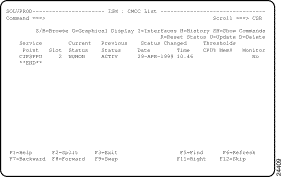
Step 2 Type U next to a service point name and press Enter. The ISM : CMCC Administration panel is displayed (Figure 7-2), showing the CMCC management definition for the selected CMCC.
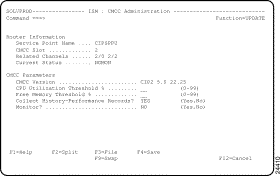
ISM issues a performance alert (status PERF) for the CMCC when the CPU utilization exceeds the percentage that you specified on this panel.
Step 4 To specify the minimum free memory threshold for the CMCCs on the router that you selected, type a value in the Free Memory Threshold % field.
ISM issues a performance alert (status PERF) for the CMCC when the free memory percentage is below the percentage that you specified on this panel.
Step 7 Press F3 to file your changes.
For information on how to enable or disable CMCC data archiving, see the "Setting Up Router CMCC Management Options" section.
After you have enabled CMCC management for the routers in the ISM Parameter Administration panels, you can monitor the status for discovered CMCCs on all routers by using the ISM : CMCC List panel (Figure 7-1). This panel displays the discovered CMCCs for routers being monitored by ISM
The color in which a CMCC status is displayed on the ISM : CMCC List panel (Figure 7-1) indicates the condition of that CMCC.
Table 7-1 lists the color and definition of each status.
| Color | Status | Meaning |
|---|---|---|
Green | ACTIV | All CMCC functions are available. |
Red | INOP | The router is active, but failed to respond to ISM during CMCC poll. |
Turquoise | INVALID | Router status is INVALID or CMCC is defined to ISM but does not exist. |
Blue | NOMON | CMCC monitoring and history are disabled. |
Yellow | PERF | The router is active, but one of the following problems exists:
|
White | UNKNOWN | CMCC is awaiting its first poll or ISM was unable to determine the status of the CMCC. |
To monitor the status of channel interfaces for routers that are being monitored by ISM, list the CMCCs, select a CMCC, and display that CMCC's channel interfaces.
Complete the following tasks to monitor channel interfaces:
Step 1 From the ISM : CMCC List panel (Figure 7-1), type I next to a service point name and press Enter. The ISM : Interface List panel is displayed, showing the channel interfaces for the selected router and slot.
Step 2 To access the ISM : Interface Administration panel for a particular interface, type S next to the interface that you want to view and press Enter.
See the "Setting Up Interface-Specific Management Options" section for further information about using the ISM : Interface Administration panel.
The CMCC hardware and software versions are displayed in the following format:
CIP x.x yy.yy
where x.x is the hardware version and yy.yy is the software version.
These versions are displayed on two ISM panels:
Complete the following steps to access the ISM : CMCC and Channel Show Commands panel and to run router show commands:
Step 1 From the ISM : CMCC List panel, type SH next to a service point name and press Enter. The ISM : CMCC and Channel Show Commands panel is displayed (Figure 7-3), with a list of show commands to issue against channel 0 of the selected CMCC port.
To access these show commands for other channels, do one of the following:

Step 2 To view help on a show command, type H next to the command and press Enter. The help is displayed on the ISM : Command Interface panel.
Step 3 To run a show command, type S next to the command and press Enter. The command output is displayed on the ISM : Command Interface panel (Figure 7-4).
 | Tips |
You need to specify the router service point name and the channel to run the show commands. When you select a router on the ISM : CMCC List panel to open the command interface, ISM automatically specifies the router and channel for you.
The show controller command is a command to the router that displays all information about the CBUS controller card or controller channel on a Cisco router. This command shows the capabilities of the card and reports any controller-related failures (Figure 7-4).
To execute the show controller command from the ISM : CMCC and Channel Show Commands panel, type S next to the show controller CBUS command or show controller channel command and press Enter. The command output is displayed on the ISM : Command Interface panel (Figure 7-4).
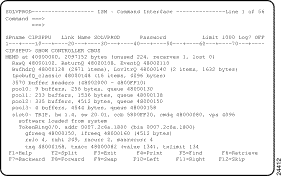
To view CMCC memory and usage statistics for a CMCC, complete the following steps:
Step 1 From the ISM : CMCC List panel, type H next to a service point name and press Enter. The ISM : CMCC History panel is displayed (Figure 7-5).
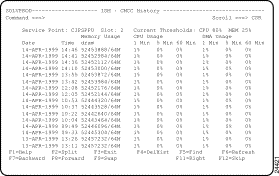
Step 2 To view additional history statistics (Figure 7-6), press F11.

Step 3 For information about the statistics on these panels, press F1 for help.
If CMCC data archiving is enabled, you can remove history and performance records from the VSAM database for a specific router using the Delete History function on the ISM : CMCC History panel (Figure 7-2). When you use the Delete History option, the history records are removed from the database when you confirm the delete.
The record wrap counts are specified on the ISM : Database Parameters panel (see the "Setting Up ISM Database Parameters" section).
Complete the following tasks to delete history and performance records for a specific router and CMCC:
Step 1 On the ISM : CMCC List panel (Figure 7-1), type H next to the router and slot for which you want to delete the history and performance records. The ISM : CMCC History panel (Figure 7-5) is displayed for the selected router and slot.
Step 2 To delete the CMCC history and performance records, press F4. The ISM : CMCC Management History Delete Panel is displayed, prompting you to confirm or cancel your delete request.
Step 3 Press F6 to confirm the delete. ISM displays a message confirming that the CMCC history records for the selected CMCC have been deleted.
To view the CMCC Graphical Display panel, complete the following steps:
Step 1 On the ISM : CMCC List panel, type G next to a service point name and press Enter. The CMCC Graphical Display panel is displayed (Figure 7-7).
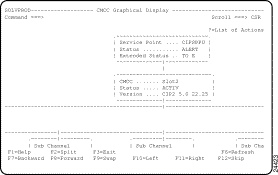
Step 2 If the router service point has multiple CMCCs, channels or sub-channels, you can Scroll left, right, up, or down to view additional information (press F7, F8, F10, or F11).
Step 3 For information about the graphical display, press F1 for help.
Step 4 To access additional information about a router resource, type ? in the entry field next to the box of the resource that you want to view, and press Enter. A list of available actions for the selected resource is displayed.
Step 5 Select one of the available actions and press Enter. The ISM panel that corresponds to the action that you selected for the resource is displayed. For example, if you select SH (Show Interfaces) and press Enter while the cursor is next to the Channel 2/0 box, the ISM : Command Interface panel is displayed, showing the output of the show interface command for Channel 2/0.
![]()
![]()
![]()
![]()
![]()
![]()
![]()
![]()
Posted: Tue Aug 24 12:09:39 PDT 1999
Copyright 1989-1999©Cisco Systems Inc.